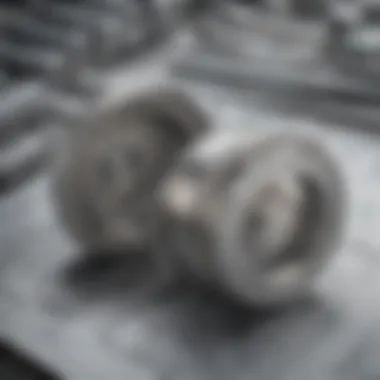Effective Strategies for Buying Silver at Spot Prices


Intro
Investing in silver can be a smart move. Many investors turn to this precious metal not only for its potential upside but also as a hedge against economic uncertainty. However, navigating the silver market can be tricky if you're not familiar with the ins and outs of buying it at near spot prices. This section sets the stage for understanding key strategies to minimize your entry costs when purchasing silver.
Knowing how to acquire silver effectively means grasping critical market dynamics. Factors that influence silver pricing can range from supply and demand fluctuations to geopolitical events. This background knowledge is vital for any investor hoping to make informed decisions. With insights into these dynamics, one can enhance their investing strategy and ultimately increase their returns.
Investment Terminology
Understanding the lingo of silver investing can make it much easier to engage with other investors, brokers, and resources. When you’re talking shop, you want to sound like you know what you're doing.
Glossary of Key Terms
- Spot Price: The current market price at which silver can be bought or sold for immediate delivery. It's essential to keep tabs on this to understand how your investments stand.
- Premium: The additional cost added to the spot price, generally due to factors such as minting, distribution, or demand. Make sure to shop around to find the lowest premiums.
- Bullion: Refers to the physical silver in bulk form, usually in coins or bars. Investing in bullion is often favored for its intrinsic value.
- Liquidity: An indicator of how easily a silver asset can be bought or sold without affecting its market price. High liquidity is generally better for investors.
Common Investment Acronyms
- ETF: Stands for Exchange-Traded Funds, which allow investors to invest in silver without having to hold the physical metal. They trade like stocks on major exchanges.
- LME: The London Metal Exchange, a global marketplace for trading metals, including silver. Prices on this exchange often influence local markets.
- COMEX: The Commodity Exchange, a platform for trading futures related to commodities, including silver futures, which can impact spot prices significantly.
Financial Product Reviews
Investing in silver can be done in several ways, including physical silver products and financial instruments. Here's how you can navigate that:
In-Depth Product Analysis
- Physical Silver Coins: These are popular among collectors and investors. American Silver Eagles or Canadian Maple Leafs are examples. The intrinsic value of these coins lies in the silver content, but always check the premiums.
- Silver ETFs: A more indirect method of gaining exposure to silver. Products like the iShares Silver Trust are designed to track the price of silver bullion. They can be more convenient, and you don't have to worry about storing physical silver.
Pros and Cons Overview
- Physical Silver
- Silver ETFs
- Pros: Direct ownership, tactile investment.
- Cons: Storage, higher premiums.
- Pros: Easy to trade, no storage hassle.
- Cons: Doesn’t provide ownership of actual silver, potential management fees.
“Investing in silver is not just about buying low and selling high. It requires a deep understanding of market forces that can knock you off your feet if you're not prepared.”
Understanding these elements is crucial as we delve deeper into strategies for making smart purchases in the silver market. After establishing this foundation, readers can confidently explore the practical tactics that can lead them to acquiring silver at or even below market rates, ensuring they have the most valuable information at their fingertips.
Understanding Silver as an Investment
Investing in silver can be a multifaceted journey. Understanding what silver represents as an investment is crucial for anyone looking to secure their financial future. This precious metal has been a store of value for centuries, often seen as a safe haven during tumultuous economic times. It’s commonly perceived as a hedge against inflation and currency devaluation, which adds layers of significance for investors.
Silver also offers a tangible asset that you can hold, unlike stocks or bonds which exist in a more abstract space. This physical aspect could be appealing for those wary of digital market fluctuations. Furthermore, silver is used not just as an investment vehicle but also in various industries such as electronics, medicine, and renewable energy, particularly solar panels. This industrial demand helps stabilize its price in a market often riddled with volatility.
Historical Context of Silver Prices
The history of silver pricing paints a complex picture. Many investors may not realize that silver was once more valuable than gold in terms of purchasing power. Back in the mid-19th century, when the discovery of silver-rich ore in places like Nevada led to the Comstock Lode, the market saw rapid changes. From the mid-1800s to around 1900, silver was commonly used in coinage, significantly influencing its price.
By the 20th century, silver's role shifted as gold became the go-to metal for reserves and a standard for currency. The advent of paper money further pushed silver into the wings, leading to price declines during the 1950s and 60s. However, as economic uncertainty grew in the 1970s, so did the price of silver, reaching unprecedented heights due to inflation and geopolitical tensions.
Current Market Trends
In today's context, silver is witnessing renewed interest. Recently, there’s been a rising chatter about sustainability and the green economy, which leverages silver’s conductivity in a multitude of applications. Many analysts believe that this could provide a steady increase in demand, potentially stabilizing prices. Moreover, similar to the post-COVID-19 recovery period, many investors are flocking to silver as a safer bet amid stock market fluctuations and inflation fears.
The rise of silver exchange-traded funds (ETFs) has made it easier for everyday investors to acquire silver without handling physical metal. This method offers liquidity and lower entry costs compared to traditional purchases of coins or bars. However, one must remain cautious, as the wild swings in price can serve as a double-edged sword for those who do not time their investments well.
Comparative Analysis of Silver and Other Precious Metals
When talking about precious metals, it's essential to compare silver with its counterparts like gold and platinum. Silver presents a balance of both, combining traits of industrial and investment demand. Unlike gold, which tends to be seen purely as a hedge against inflation, silver’s price is tied closely to industrial needs, which can lead to significant price differences based on market conditions.
In contrast, platinum has also seen fluctuating prices due to its rarity, but its high industrial demand puts it in a different risk category. Investors might consider the volatility of market conditions when weighing their options.


"Historically, silver serves as a precious bridge between raw industrial demand and the gold standard, making it unique in the precious metal landscape."
In summary, understanding silver as an investment involves recognizing its historical significance, tracking current market trends, and comparing it with other precious metals. This comprehensive perspective will arm potential investors with the knowledge needed to make informed decisions as they navigate the silver market.
Defining Spot Price in Precious Metals
Understanding the concept of spot price is crucial for anyone looking to invest in precious metals, particularly silver. It is the market price at which silver can be bought or sold for immediate delivery. This price fluctuates constantly based on various market influences and offers a crucial benchmark for investors.
When you think about investing in silver, grasping the significance of spot price is like knowing the current pulse of the market. It helps investors recognize the potential risks and rewards associated with any purchase. Being informed about the spot price allows you to determine whether you are paying a fair price or getting shortchanged.
Factors Influencing Spot Prices
Several key factors come into play regarding the fluctuation of silver spot prices:
- Supply and Demand Dynamics: Just like many commodities, silver's price is closely linked to its availability. An increase in mining output can lower prices, while production disruptions tend to push values higher. Conversely, demand from various sectors like electronics, jewelry, and even investment can cause spikes.
- Economic Indicators: The overall economic climate influences investor sentiment. In times of economic uncertainty or inflation, demand for silver as a hedge tends to rise, often increasing its spot price.
- Currency Strength: The value of the U.S. dollar also plays a vital role. A weaker dollar typically leads to higher silver prices, as it costs more to buy silver priced in dollars. When traders perceive the dollar as strong, silver and other commodities can see a decline in price.
- Geopolitical Events: Events such as conflicts or political instability in silver-producing countries can also impact supply chains, leading to price changes.
This combination of diverse factors makes predicting spot prices rather complex yet essential.
"Identifying and monitoring these aspects are vital for timely and strategic purchasing decisions."
How Spot Price is Determined
Determining the spot price of silver is an intricate process, grounded in various market transactions:
- Market Exchanges: Spot prices are primarily established on commodity exchanges like the London Metal Exchange and the New York Mercantile Exchange. Here, traders buy and sell silver contracts, which leads to price determinations based on real-time transactions.
- Global Market Activity: Prices are influenced by international trading activity as silver is a global market. For example, if trading activity surges in Asian markets, it can lead to shifts in spot prices even for Western investors.
- Physical and Paper Markets: The spot price reflects the cost of physical silver as well as the price of futures contracts. Buyers participating in either market rely on this price as a benchmark for their transactions.
- Investor Sentiment: Market perception also contributes heavily. If investors feel optimistic about silver's future, they may be willing to pay more, thus driving up the spot price.
For savvy investors, paying attention to these dynamics can lead to effective purchasing strategies. Knowing how market forces shape silver's spot price can put you in a better position to make informed decisions."
In summary, defining and understanding the spot price of silver is a vital element in any investment strategy related to precious metals. Gaining insights into the myriad factors influencing these prices empowers investors to engage more confidently in the market.
Methods to Acquire Silver Close to Spot Price
Acquiring silver at or near its spot price is no small feat, especially in today’s fluctuating market. This section aims to shed light on effective methods for securing silver without overspending, providing the necessary understanding for investors. Recognizing where to source silver and the strategies that work best can effectively minimize costs while maximizing investment potential.
Physical Bullion Purchases
Buying physical silver remains one of the most direct methods. However, how does one choose between bars and coins, and should one rely on local dealers or take to online platforms?
Bars vs. Coins
When it comes to purchasing physical silver, bars and coins both have their merits. Bars typically offer lower premiums over the spot price due to their larger size. Buying a one-kilogram bar means you pay less per ounce compared to smaller denominations. On the flip side, coins are often seen as more liquid assets. For instance, the American Silver Eagle is widely recognized and can be easier to sell in the future, even if it commands a higher premium at purchase.
- Benefits of Bars:
- Advantages of Coins:
- Lower Premiums: The larger the bar, the lower the cost per ounce.
- Storage Efficiency: Less space taken up for the same amount of silver.
- High Liquidity: They are easier to sell and recognized by more buyers.
- Collectable Value: Some coins may appreciate beyond their silver value.
Ultimately, the choice between bars and coins depends on individual investment goals and liquidity needs.
Local Dealers vs. Online Suppliers
Choosing between local dealers and online suppliers can feel like a toss-up. Local dealers can provide immediate physical possession, allowing you to inspect items before purchase. However, they might have higher markups. Meanwhile, online suppliers often have a wider selection and competitive pricing, but you must account for shipping and potential wait times.
- Pros of Local Dealers:
- Pros of Online Suppliers:
- Immediate Access: You can take your silver home right away.
- Personal Interaction: You have the ability to haggle over price and inspect pieces closely.
- Greater Variety: The internet opens doors to many options at your fingertips.
- Potentially Lower Prices: Some online retailers offer lower premiums than local shops.
Deciding which route to take can often hinge on convenience, costs, and personal preferences for interaction.


Silver Futures and ETFs
Investing through futures and ETFs is a different ball game that doesn’t involve the physical handling of silver but can also provide close access to spot pricing.
Understanding Futures Contracts
Futures contracts allow investors to lock in a price today for a purchase in the future. This method can be beneficial when anticipating upward price movements. However, it is essential to conduct thorough market research, as timing inaccuracies can lead to significant losses. Futures trading isn’t for the faint of heart and requires a fair understanding of market dynamics.
- Key Features:
- Leverage: You can control more silver than you could afford outright.
- Market Access: Opens doors to speculating on price changes.
Advantages of Silver ETFs
Silver ETFs offer a simplified way to gain exposure without the hassle of physical ownership. These funds represents silver assets, usually held in trust, and trade like stocks.
- Key Benefits:
- Low Transaction Costs: Compared to buying bars or coins, expense ratios are typically lower.
- Diversification: They allow for easier investment strategies without needing to deal with storage or insurance costs.
Participating in Auctions
Auctions can be an overlooked source of silver, providing another opportunity to buy at competitive prices. By attending either in-person or online auctions, savvy investors can potentially snag better deals.
Often the thrill of bidding and potential for lower entry points attune experienced buyers to the art of auctions. However, it’s essential to remain disciplined. It’s easy to get swept up in the momentum and bid more than intended.
In summary, whether it's through physical purchases, futures, ETFs, or auctions, finding silver at spot prices involves assessing one's goals, knowledge, and risk appetite. Diversifying purchase strategies opens more doors to success in this fascinating yet challenging investment market.
Timing the Buy: Market Strategies
Timing the purchase of silver plays a critical role in maximizing profitability and ensuring that investors acquire this precious metal at the most advantageous prices. The silver market, much like a pendulum, experiences fluctuations influenced by various economic indicators, geopolitical events, and market sentiment. Having a well-thought-out strategy can make all the difference when it comes to timing your buy. In this section, we will delve into two key components that can greatly affect your investment decisions: identifying optimal buying opportunities and utilizing technical analysis.
Identifying Optimal Buying Opportunities
Identifying optimal buying opportunities means knowing when to enter the market. This requires keen observation and analysis of different factors. Here are some of the common indicators you should consider:
- Seasonal Trends: Silver prices tend to follow certain patterns depending on the time of year. For instance, demand often spikes during the holiday season or in periods of economic uncertainty. Being aware of these seasonal trends can help you pinpoint potential buying windows.
- Economic Indicators: Key economic reports, such as unemployment rates, inflation data, and interest rates, can impact silver prices. When inflation rates rise, investors might flock to silver as a hedge, increasing its price. Keeping tabs on these indicators helps you anticipate market shifts.
- Global Events: Events like political turmoil, trade wars, or natural disasters can cause significant movements in the silver market. For instance, during the recent pandemic, many investors turned to silver for safety, causing price surges. Being abreast of current affairs can aid you in timing your buy.
- Market Sentiment: The overall mood regarding the economy can sway prices. If investors are particularly optimistic or pessimistic, it can set the stage for price changes. Tools like the Silver Sentiment Index can provide insights into the collective feelings of market participants.
By carefully analyzing these factors, you can position yourself to buy silver when prices are favorable, thus positioning your investment for long-term growth.
Utilizing Technical Analysis
Technical analysis operates on the premise that historical price movements can help predict future performance. This strategy involves studying price charts and other market data to identify patterns and trends that may indicate when to buy silver. Here are some essential concepts related to technical analysis:
- Support and Resistance Levels: Support levels are price points where silver tends to stop falling and may bounce back up, whereas resistance levels are where it rallies before dropping. Recognizing these levels allows investors to make educated decisions on when to buy. If silver approaches a support level, it may be a good time to consider buying.
- Moving Averages: Moving averages smooth out price data to identify trends over a specific period. A commonly used type is the 50-day moving average. If the price of silver crosses above this average, it can signal that it's time to buy, reflecting positive market momentum.
- Relative Strength Index (RSI): The RSI is a momentum oscillator that measures the speed and change of price movements. If an RSI reading falls below 30, it typically suggests that silver is oversold, which might signify a buying opportunity as prices may correct upwards.
- Chart Patterns: Recognizing chart patterns like head and shoulders, double tops, or flags can provide insights into possible price movements. These patterns can signal potential reversals or continuations in price trends, thus guiding your buying decisions.
Utilizing technical analysis isn't foolproof, but it gives investors the tools to leverage market data effectively.
"Success in investing is what you do with initial information not just having it."
By combining understanding market timing strategies with an analysis of timing indicators, investors can not only improve their chances of purchasing silver at or near spot prices but also travel down the path of informed decision-making regarding their investments.
Risks and Challenges of Investing in Silver
Investing in silver can offer great returns, but it’s like walking on a tightrope; one misstep could result in significant losses. Understanding the risks and challenges associated with silver investment is crucial for anyone looking to dive into this volatile market. It’s not all sunshine and rainbows; factors such as market volatility, liquidity issues, and authenticity concerns can complicate the journey. Let’s take a closer look at these elements and consider what they mean for investors.
Market Volatility
Silver prices do not follow a predictable path. The market can swing like a pendulum, influenced by a plethora of macroeconomic factors. For instance, changes in global economic conditions, currency fluctuations, or even geopolitical tensions can cause silver prices to jump up or down at the drop of a hat.
It's essential to keep an eye on market trends, as prices can exhibit erratic behavior, leaving investors wondering if they made the right decision. During periods of economic uncertainty, silver often sees increased demand as a safe haven asset. However, this demand can dry up just as quickly once confidence in the economy returns, leading to price drops that can take the uninformed investor by surprise.


"Understanding market volatility is like knowing the pulse of the silver investment; it's an essential but tricky dance."
Liquidity Concerns
When it comes to liquidity, not all silver investments are created equal. While silver is generally considered liquid, the ease of selling can vary significantly between different forms of silver investments. For example, coins are often easier to sell than larger bullion bars, particularly if you are dealing with local dealers who may prefer coins over bars for quick transactions.
Another aspect to consider is timing. Even if you own a substantial amount of silver, if the market takes a dive, find a buyer quickly can be a challenge. If your investment is tied up in an illiquid asset, you could be stuck waiting for the market to recover, which can be distressing, especially during periods of sudden necessity for cash.
Ensuring Authenticity and Quality
One of the most significant risks in silver investment is ensuring the authenticity and quality of the product you are purchasing. Counterfeit silver is a genuine issue, and being swindled can eradicate your investment overnight. Quality refers not just to authenticity but also to the overall grade of the silver; high-quality silver typically retains its value better.
Before making a purchase, it's wise to vet dealers and seek out reputable sources. Examine products thoroughly and consider certifications that can back up the authenticity of your silver. If you’re purchasing online, always check reviews and look for established sellers with a good track record.
To sum things up, being aware of these risks can help reduce the likelihood of costly mistakes. In the world of silver investment, a little preparation and knowledge can truly go a long way.
Maintaining Your Silver Investment
When it comes to investing in silver, simply acquiring the metal at favorable prices is just the beginning. Maintaining your silver investment is crucial for leveraging its long-term value. It’s not merely about greenbacks spent at the point of purchase; it’s about protecting that asset over time, ensuring it remains a sound investment that can yield benefits as the market fluctuates. In this section, we’ll discuss some key considerations and practical tips for keeping your silver investment intact and flourishing.
Safe Storage Solutions
The first step to maintaining silver is finding the right storage solution. Storing silver safely is akin to safeguarding a treasure trove. Not only does it diminish the risk of theft, but it also helps to prevent any physical damage to the metal. Here are several storage options to consider:
- Home Safe: A personal safe can provide security at home. Look for a heavy-duty safe that is fireproof and waterproof. The secret’s not just in buying it, but also in securely anchoring it in place so that it doesn’t walk out of the door.
- Bank Deposit Boxes: For those who prefer a more secure location, a safety deposit box at your bank can be a wise choice. While this does involve a rental fee, the peace of mind it brings is invaluable.
- Third-Party Vaults: Specialized storage facilities offer vault services specifically for precious metals. These setups usually have top-notch security and insurance.
Remember, when selecting a storage method, consider accessibility and cost. You don’t want to be scrambling to find your assets simply because you can’t remember which box you kept them in.
Tracking Value Over Time
Tracking your silver’s value is where the real savvy investor shines. It goes beyond just looking at the price tag on any given day. Regularly monitoring market trends and how they affect the spot price of silver is vital for any investor’s strategy. Here are targeted strategies for keeping tabs on your investment:
- Set Alerts: Utilize online platforms and apps that let you set alerts for silver price changes. Getting notified helps you stay informed without constantly checking.
- Use a Spreadsheet: Create a simple spreadsheet detailing your purchases, current valuations, and market shifts. This method provides a clear visual of how your investment is performing.
- Follow Market News: Staying in touch with market trends and news can provide insights into potential shifts that could affect silver prices. Websites like reddit.com have forums dedicated to precious metals, where enthusiasts often discuss market movements.
Regularly evaluating the value of your investment allows you to make informed decisions, whether that involves holding, selling, or even acquiring more silver at opportune times.
"In investing, what is comfortable is seldom profitable." - Robert Arnott
By maintaining your silver investment with secure storage and continuous monitoring, you enhance its potential for attractive returns. This proactive approach helps position you better in the fluctuating landscape of the silver market.
Culmination: Navigating Your Silver Investment Journey
In embarking on a venture into silver investment, wrapping your head around the strategies for buying at near spot prices is absolutely crucial. The journey we’ve traversed throughout this article sheds light on the nuanced balance between tactics and timing. Understanding the intricacies of the silver market can not only empower you but also enhance your investment outcomes.
This conclusion serves as a compass, helping you to navigate through the complicated landscape of silver acquisition. We’ve discussed various pathways—from grasping the fundamentals of spot prices to evaluating market trends and understanding the risks involved. These elements are not just trivia; they are building blocks that contribute essential insights to your investment strategy.
Benefits of strategizing your silver investment include:
- Cost Efficiency: With a well-thought-out plan, you can significantly minimize unnecessary expenses.
- Informed Decision-Making: Knowledge about market dynamics equips you to make choices that align with your financial goals.
- Risk Mitigation: A clear strategy helps in identifying potential pitfalls and navigating them effectively.
In essence, navigating your silver investment journey isn’t just about acquiring precious metals; it’s about adopting a mindset that prioritizes education and strategic thinking above all else. By stitching together the insights from different sections of this article, you can lay a solid foundation for successful silver investment.
Summarizing Key Takeaways
To crystallize what we've seen, here are a few key takeaways:
- Grasp the current trends and historical context of silver prices to make well-informed investment decisions.
- Understand the concept of spot price and what factors influence it, helping you capture silver at favorable rates.
- Explore various methods to acquire silver—be it through physical purchases, futures, or auctions—and recognize the advantages and disadvantages of each method.
- Be vigilant about market volatility and liquidity, ensuring you are aware of the challenges that come with investing in silver.
- Maintain your investment through safe storage and regular value tracking to protect your financial asset’s worth.
Future Projections for the Silver Market
Peer into the crystal ball of the silver market, and you’ll find that projections can often feel like a guessing game. However, some patterns can give us insights about where the market might be heading.
A few probable future trends include:
- Technological Innovations: The push for green technologies, like solar panels, may continue to drive silver demand, making it pivotal for future growth.
- Economic Conditions: Potential inflation or shifts in global economic stability can impact investor behavior, altering silver prices in the long term.
- Investment Diversification: Increasingly, more investors are considering silver as a diversification tool, especially in uncertain times, which may keep demand buoyed.
In a nutshell, keeping a finger on the pulse of these patterns can be invaluable. It not only prepares you for upcoming shifts but also positions you to make timely decisions that align with your investment philosophy.







